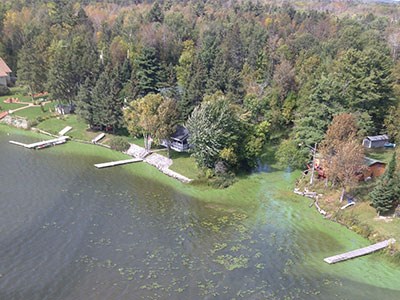When you’re in the environmental research business, finding blue-green algae can be a double-edged sword: it’s good for the researchers, but not so good for the people living in the area.
A collaborative research project between environmental engineering firm Canadian Shield Consultants and the Northern Ontario School of Medicine (NOSM) is using aerial infrared technology combined with lab analysis to try to predict where the blooms are and stop them before they spread.
“With the camera technology, we can take pictures, and we think we can discern whether we’re looking at a green algal bloom, which is totally normal — they don’t produce toxins — versus blue-green algae, or a cyanobacteria bloom, which could potentially have some serious health effects,” said NOSM researcher Joe Eibl.
Human exposure to blue-green algae can cause vomiting, diarrhea, skin irritation, breathing difficulties, dizziness and numbness in the limbs. Its presence usually results in closed beaches and boil-water advisories until the algae runs its course and the water is deemed safe again — sometimes taking several weeks.
“The idea is that if you can detect these early enough, then you can potentially remediate them, before they turn into a bloom, and/or dissipate the water,” Eibl said.
Eibl had previously been studying the use of green-blue algae in the production of biofuels. He teamed up with Dignard, whose business is based out of St. Charles an hour outside of Sudbury, while conducting research in Musky Bay in Lake Nipissing.
Dignard, who spent 32 years working for Agriculture Canada before opening his own firm 15 years ago, has had a long-time interest in environmental remediation.
Canadian Shield Consultants provides turnkey, on-site wastewater and water treatment systems for clients in mining, forestry, tourism and residential developments. It engineers, designs, manufactures, installs and maintains the self-contained systems, which are used primarily in remote areas inaccessible by road.
Last year, he launched the Environmental First Response division, which oversees and prepares cleanup plans for spills of non-environmentally friendly materials that pose a threat to the environment. The company helicopter plays a key role in getting the aerial infrared photographs for the current research.
As an environmental engineering firm, Dignard sees his company as a steward of the environment whose interest is more than just profit-driven.
“Being a firm that does that kind of stuff, it’s more than just making dollars to become richer,” he said. “It’s being part of something we believe and part of our mission statement.”
Dignard has been experimenting with different technology to find ways of remediating the algal blooms once they are detected. He’s currently researching the use of ultrasonic waves to prevent the blooms, which thrive in warm temperatures and waterways with reduced flow.
Solar-powered ultrasonic wave units could be installed on shorelines where blue-green algae are suspected, and the frequency would disrupt the water, Dignard explained.
“We’re very early in the research stage, but every indication is that one unit would service 1,500 square feet in the direction of flow,” he said. “It would mean installing some in front of your cottage if you had blue-green algae, so you would prevent the bloom from moving around.”
Now in the second year of his research, Eibl has expanded his search area beyond Musky Bay, where his field office is located, to other waterways across the North.
“Any bloom that comes up in our region, we’re looking at it,” he said.
His results over the course of the summer will determine the next phase of the project, but the next step would be to translate his results into a working strategy.
Consultation would be required with the Ministry of Environment and other stakeholders before moving forward, he said, but he’d like to implement the process in an actual waterway, especially one that has a perennial and persistent problem with blue-green algae.
Eventually, the project could lead to commercialization of the technology, although Eibl is hesitant to put a definitive timeline on it.
“Once you prove the technology, blue-green algae is an issue in a lot of places around the world, so it would definitely be for the North,” he said, “but it could be applied globally.”




